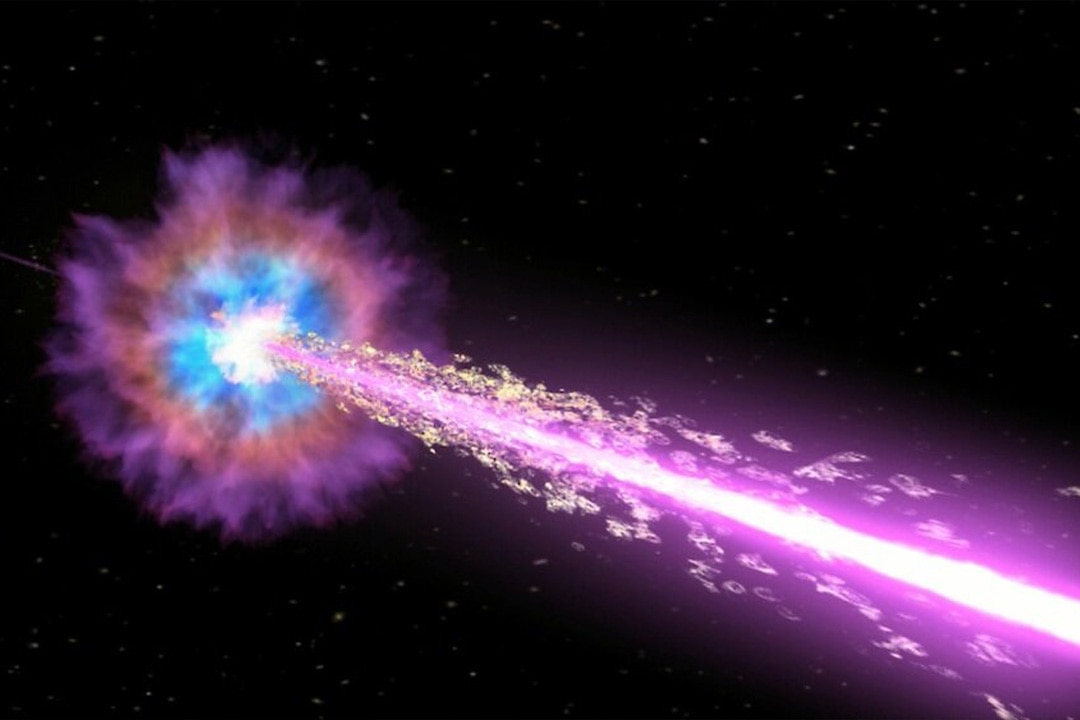In the 1960s, the United States, the United Kingdom, and the Soviet Union signed a treaty banning nuclear weapons tests inside Earth’s atmosphere. Shortly thereafter, the U.S. Air Force launched the Vela satellites, 12 surveillance devices parked in Earth orbit. Their job was to look for gamma rays produced by the now-banned weapons tests.
Over the next several years, the satellites picked up 16 intense flashes of gamma radiation, but they weren’t coming from Earth. By 1973, astronomers had learned enough about these mysterious outbursts to publish the results. What became known as gamma-ray bursts (GRBs) are the most energetic and explosive events in the universe.
They can be a quintillion times brighter than the Sun, but they typically last for only a moment. Many are as brief as a fraction of a single second. Recently, astronomers observed an unusually long GRB, the final gasp of a star being consumed by a black hole from the inside. That death rattle ran on for seven long hours.
A star being eaten by a black hole created the longest explosion ever observed
GRBs usually last between a fraction of a second and a couple of minutes, and how they behave tells astronomers something about where they originated. Shorter bursts are generated by the merger of two neutron stars or a neutron star and a black hole. The collision results in a new black hole and pumps out gamma rays in the process.
Long ones happen when massive stars run out of fuel to fuse. The core collapses and bounces back, pushing a shockwave through the star. At the other end of this explosive supernova, you might get a neutron star or a black hole, beaming jets in opposite directions at nearly the speed of light. As they carve through and interact with other matter, they produce gamma rays which can be detected from Earth.
This particular cosmic explosion, detected July 2, 2025 by the Fermi Gamma-ray Burst Monitor and dubbed GRB 250702B, released a boat load of energy, enough that it should have been a rapid burst. Instead, it stretched on for a record-breaking seven hours. It beat the previous record by nearly three hours and had energy levels significantly higher than typical GRBs.
In a paper posted to the preprint server arXiv, researchers noted that the spectrum and energy levels detected are only known to come from the ultrarelativistic (very close to the speed of light) jets churned out by a rapidly spinning cosmic engine. The characteristics of GRB 250702B made it incompatible with known GRB sources.
Researchers even eliminated the possibility of a black hole consuming a star from the outside, a process which happens mostly at the centers of galaxies (where the most massive black holes hang out) because this explosion occurred outside the galactic center. Without an ordinary answer at hand, the team went looking for a less conventional explanation, and they found it in something known as the helium merger model.
The disastrous explosion was the end result of an ill-fated set of binary stars. One of the stars had already collapsed into a black hole while the other was still shining. Binary stars can remain in this configuration long-term, provided the remaining star keeps its distance from the black hole’s event horizon. Unfortunately, the second star was aging.
You probably know that when the Sun eventually sings its swan song it’s going to swell in size, consuming the inner solar system planets. That’s because of a complex relationship between the mass lost through fusion which lowers a star’s inward gravitational pressure and changes in the core which increase outward pressure. In this distant alien star system, the remaining star swelled to consume its black hole companion.
Once inside, the black hole started churning through the star’s outer layers. Friction from inside the star slowed the black hole down until it spiraled into the star’s core. By the time it got there, it was carrying a lot of angular momentum, like a figure skater pulling their arms in during a spin. Instead of swallowing the star in one big gulp, it flung the star out in a ring, like pigment on a paint spinner, creating an accretion disk of stellar matter around the black hole.
It’s the disk whipping wildly around the black hole as it was slowly consumed which created the ultrarelativistic jets and the gamma rays astronomers detected. It’s a reminder of how much we still don’t know about the universe and the powerful creative and destructive powers at work out there in the dark.
Cozy up to destruction on a slightly smaller scale in The End is Nye, streaming now on SYFY.

